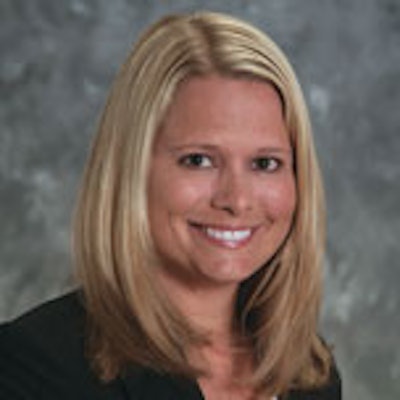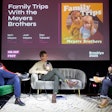
Courtney Saylor
Title: Vice president of special events for Warner Brothers
What She Plans: “We release about 20 films a year, so we plan anywhere from 20 to 30 related events every year. Plus we work on all the film festival events—like in TriBeCa and Toronto. Anything domestic, we plan.” Saylor also works on an array of awards show-related events—like the Golden Globes party with In Style magazine and a dinner party for Oscar nominees. And when needed, her department assists the Warner Home Video division with its events.
Staff: A senior publicist, a manager, and a temporary assistant.
Budget: “It depends on the film, depends what we are doing, depends on how many events we’re doing to launch a film. If we have sponsorship it all changes.”
Career Path: “In college I interned at Paramount and worked in media relations on television. I went to school at USC, and I have a B.S. in business marketing. My first job after school was at Miramax. One of the things about TV is that when you are working with the producers, you are working with them for years. And I liked the pace of motion pictures where you could be working on something for six weeks or six months and it’s constantly changing.” Saylor joined Warner Brothers in 1999, and worked her way up to her current title.
Age: 31
Where She Lives: Manhattan Beach
Where She Grew Up: Pasadena
Where She Goes for Ideas: “I read magazines but I get ideas just by going out anywhere, and going to other people’s events. Going out in L.A. to the opening of a club will definitely give you ideas. We have a lot of big parties so we’re kind of limited in where we can go with enough space to fit everyone we invite.”
Favorite Venue: Parking lots. “Because I can transform them into anything I want.”
Favorite Hors d’oeuvres: “Everyone makes fun of me because I always make them put chicken on the menu. I personally don’t eat seafood, but I love the look of seafood and ice buffets and things like that because I think they look very grand—but I don’t eat it.”
Favorite Movie: The Usual Suspects
Favorite Book: “I live at the beach and I constantly read there, so I don’t know that I have one favorite book. I’m reading Under the Banner of Heaven right now.”
Favorite Magazine: “People or Us Weekly is where we find out what’s going on with everybody, but I would say In Style or Vanity Fair I like the best.”
Favorite Band: “I’m a big fan of Jack Johnson.”
Favorite Neighborhood: “Manhattan Beach—it’s part of L.A. that doesn’t feel like you’re in L.A.”You were recently promoted to vice president of special events and have taken on the new responsibility of securing sponsors. What are the new challenges?
Trying to find sponsorship opportunities is definitely another full-time job. My job is to go out and find corporations and companies interested in putting money into premieres. When I first started we weren’t allowed to have that. The former head of our studio wouldn’t allow us to promote our films with third-party companies. Now in addition to the filmmakers and the talent and the studio to look out for, you have to also look out for another party and you have to protect their interests as well. Sometimes it’s the balance between what they want and what the studio would want and trying to find a middle ground in there and trying to keep everybody happy. [The sponsor] has a financial interest, and if you want to work with them again, you have to balance it and make sure they are getting what they deserve out of it. It’s harder too because you have to go out and find them, pitch them, put them under contract. It’s a huge job in addition to the events. But at the end of the day, it’s the difference between mediocre budgets and having a regular premiere or having a premiere with a wow factor.
What are some sponsorship challenges you’ve been forced to work around?
We wanted our May 10 Poseidon premiere to be on a cruise ship. We thought it could be very interesting and they could talk about ship safety and what they do. We did have some initial interest and we were very close to signing one. But the film is about a ship flipping over, and after we tried absolutely every single cruise ship, we just realized it was not going to fly. So then we thought about something like Dramamine; we were trying to come up with different avenues of prescription drugs or anything that could counterbalance seasickness. What we ended up doing was re-creating the ship’s ballroom at the Hollywood and Highland complex. We re-created the ship’s entrance with the carpet out in front, and our invitations were an itinerary for a cruise. When the film started, we had a horn blowing.
It’s tough to find new venues in a town that has premieres almost every night. How do you do it?
The Superman premiere is on June 22 and it’s a four-month planning process. We are taking a field at the V.A. Hospital in Westwood and we are going to re-create different parts of the film from the Clark farm to the Fortress of Solitude with ice and an ice bar. And we are also re-creating a whole city view—it’s going to be just massive. It’s an 1,800-person party, and it’s a benefit for the USC Film School. In order to re-create the film, we spend a lot of time in our prop houses looking at the props from the film, and figuring out how we can repurpose them with what we’re doing at the party. We of course work closely with the filmmakers. Bryan Singer, the director, wants to know everything going on and so do the producers. They are very involved so we’re trying to get everything set the way we want it and then we’ll present it to them and get their sign-off.
You like to use unadorned spaces like fields and parking lots—as you did for The Polar Express and Divine Secrets of the Ya-Ya Sisterhood. How do you find them?
I look at the film. You can take different parts and different themes and even though you’re never going to re-create exactly what they see in the film, you can get inspired. I like spaces that are kind of raw that you can re-create and make into whatever you want. My favorite still to this day—and it was a really simple event—was that Ya-Ya Sisterhood party. It was a picnic. It was out on the Wadsworth lawn, we had a Cajun band playing, Southern food, and it was so much fun. It was just a nice night with very simple lighting and it didn’t cost a ton of money.
We use parking lots constantly. We did Polar Express in the parking lot right next to the [Grauman’s] Chinese [Theatre] and we created a whole winter wonderland with snow, games and animals for the kids, and a train running throughout it. When we did Harry Potter this past year, we did it in a church in New York and it was fantastic. It had the look of the Grand Hall.
You have also been changing tactics by doing smaller, more targeted events. Talk about your changing strategy.
We have about four tentpole films that we work with a year and we try and do them big and grand. Those are the films that our studio pretty much rests on all year. But we also have the films that are smaller in budget but don’t necessitate a 1,500-guest party. You can do something that’s a little bit more intimate that makes sense for the film. With something like The Lake House with Keanu Reeves and Sandra Bullock, instead of a big party you can do a big screening, which is where we get all of our publicity in the first place, and the party is really just an added bonus. We invite the filmmakers and the talent and the studio, and we usually scale it down to about 400 people. This way we can put more money into advertising and take money away from a premiere without feeling the effect on an opening. It doesn’t really change anything in regards to press because everything we get is on the red carpet. So we’ll scale down for the party, but still have an 1,100-person screening. The red carpet is there, the press is there, the talent, the celebrities—and you don’t miss out on your publicity.
Of course, it’s hard to do a small party and it’s hard to keep a list so small because you’re constantly saying no. How do you tell someone that their grandma can’t come? It’s not an easy thing to do.
Warner Brothers had a better year last year than we have had in any year in history, so our change in strategy is not about a box office slump. But I think people are making more movies and to do something different is what’s getting to be more challenging. I think we’re trying to come up with different things and instead of constantly outdoing ourselves with bigger premieres, we’re coming up with smaller, smarter ideas too.
You do premieres on both coasts. What’s the advantage of each?
We’ve actually been leaning more toward New York events because our films are being released nationally and internationally so close together. So when we’re sharing the talent and filmmakers, we sometimes get them for a one-week period and in those cases you’re going to take them in New York because of all the press they can accomplish out there—and we’ll still do something in L.A. just for the industry. But for the most part our biggest blockbuster events each year are still in L.A.
—Kim Serafin
Posted 05.15.06
Photo: Kevin Winter/Getty Images (Poseidon)
Title: Vice president of special events for Warner Brothers
What She Plans: “We release about 20 films a year, so we plan anywhere from 20 to 30 related events every year. Plus we work on all the film festival events—like in TriBeCa and Toronto. Anything domestic, we plan.” Saylor also works on an array of awards show-related events—like the Golden Globes party with In Style magazine and a dinner party for Oscar nominees. And when needed, her department assists the Warner Home Video division with its events.
Staff: A senior publicist, a manager, and a temporary assistant.
Budget: “It depends on the film, depends what we are doing, depends on how many events we’re doing to launch a film. If we have sponsorship it all changes.”
Career Path: “In college I interned at Paramount and worked in media relations on television. I went to school at USC, and I have a B.S. in business marketing. My first job after school was at Miramax. One of the things about TV is that when you are working with the producers, you are working with them for years. And I liked the pace of motion pictures where you could be working on something for six weeks or six months and it’s constantly changing.” Saylor joined Warner Brothers in 1999, and worked her way up to her current title.
Age: 31
Where She Lives: Manhattan Beach
Where She Grew Up: Pasadena
Where She Goes for Ideas: “I read magazines but I get ideas just by going out anywhere, and going to other people’s events. Going out in L.A. to the opening of a club will definitely give you ideas. We have a lot of big parties so we’re kind of limited in where we can go with enough space to fit everyone we invite.”
Favorite Venue: Parking lots. “Because I can transform them into anything I want.”
Favorite Hors d’oeuvres: “Everyone makes fun of me because I always make them put chicken on the menu. I personally don’t eat seafood, but I love the look of seafood and ice buffets and things like that because I think they look very grand—but I don’t eat it.”
Favorite Movie: The Usual Suspects
Favorite Book: “I live at the beach and I constantly read there, so I don’t know that I have one favorite book. I’m reading Under the Banner of Heaven right now.”
Favorite Magazine: “People or Us Weekly is where we find out what’s going on with everybody, but I would say In Style or Vanity Fair I like the best.”
Favorite Band: “I’m a big fan of Jack Johnson.”
Favorite Neighborhood: “Manhattan Beach—it’s part of L.A. that doesn’t feel like you’re in L.A.”You were recently promoted to vice president of special events and have taken on the new responsibility of securing sponsors. What are the new challenges?
Trying to find sponsorship opportunities is definitely another full-time job. My job is to go out and find corporations and companies interested in putting money into premieres. When I first started we weren’t allowed to have that. The former head of our studio wouldn’t allow us to promote our films with third-party companies. Now in addition to the filmmakers and the talent and the studio to look out for, you have to also look out for another party and you have to protect their interests as well. Sometimes it’s the balance between what they want and what the studio would want and trying to find a middle ground in there and trying to keep everybody happy. [The sponsor] has a financial interest, and if you want to work with them again, you have to balance it and make sure they are getting what they deserve out of it. It’s harder too because you have to go out and find them, pitch them, put them under contract. It’s a huge job in addition to the events. But at the end of the day, it’s the difference between mediocre budgets and having a regular premiere or having a premiere with a wow factor.
What are some sponsorship challenges you’ve been forced to work around?
We wanted our May 10 Poseidon premiere to be on a cruise ship. We thought it could be very interesting and they could talk about ship safety and what they do. We did have some initial interest and we were very close to signing one. But the film is about a ship flipping over, and after we tried absolutely every single cruise ship, we just realized it was not going to fly. So then we thought about something like Dramamine; we were trying to come up with different avenues of prescription drugs or anything that could counterbalance seasickness. What we ended up doing was re-creating the ship’s ballroom at the Hollywood and Highland complex. We re-created the ship’s entrance with the carpet out in front, and our invitations were an itinerary for a cruise. When the film started, we had a horn blowing.
It’s tough to find new venues in a town that has premieres almost every night. How do you do it?
The Superman premiere is on June 22 and it’s a four-month planning process. We are taking a field at the V.A. Hospital in Westwood and we are going to re-create different parts of the film from the Clark farm to the Fortress of Solitude with ice and an ice bar. And we are also re-creating a whole city view—it’s going to be just massive. It’s an 1,800-person party, and it’s a benefit for the USC Film School. In order to re-create the film, we spend a lot of time in our prop houses looking at the props from the film, and figuring out how we can repurpose them with what we’re doing at the party. We of course work closely with the filmmakers. Bryan Singer, the director, wants to know everything going on and so do the producers. They are very involved so we’re trying to get everything set the way we want it and then we’ll present it to them and get their sign-off.
You like to use unadorned spaces like fields and parking lots—as you did for The Polar Express and Divine Secrets of the Ya-Ya Sisterhood. How do you find them?
I look at the film. You can take different parts and different themes and even though you’re never going to re-create exactly what they see in the film, you can get inspired. I like spaces that are kind of raw that you can re-create and make into whatever you want. My favorite still to this day—and it was a really simple event—was that Ya-Ya Sisterhood party. It was a picnic. It was out on the Wadsworth lawn, we had a Cajun band playing, Southern food, and it was so much fun. It was just a nice night with very simple lighting and it didn’t cost a ton of money.
We use parking lots constantly. We did Polar Express in the parking lot right next to the [Grauman’s] Chinese [Theatre] and we created a whole winter wonderland with snow, games and animals for the kids, and a train running throughout it. When we did Harry Potter this past year, we did it in a church in New York and it was fantastic. It had the look of the Grand Hall.
You have also been changing tactics by doing smaller, more targeted events. Talk about your changing strategy.
We have about four tentpole films that we work with a year and we try and do them big and grand. Those are the films that our studio pretty much rests on all year. But we also have the films that are smaller in budget but don’t necessitate a 1,500-guest party. You can do something that’s a little bit more intimate that makes sense for the film. With something like The Lake House with Keanu Reeves and Sandra Bullock, instead of a big party you can do a big screening, which is where we get all of our publicity in the first place, and the party is really just an added bonus. We invite the filmmakers and the talent and the studio, and we usually scale it down to about 400 people. This way we can put more money into advertising and take money away from a premiere without feeling the effect on an opening. It doesn’t really change anything in regards to press because everything we get is on the red carpet. So we’ll scale down for the party, but still have an 1,100-person screening. The red carpet is there, the press is there, the talent, the celebrities—and you don’t miss out on your publicity.
Of course, it’s hard to do a small party and it’s hard to keep a list so small because you’re constantly saying no. How do you tell someone that their grandma can’t come? It’s not an easy thing to do.
Warner Brothers had a better year last year than we have had in any year in history, so our change in strategy is not about a box office slump. But I think people are making more movies and to do something different is what’s getting to be more challenging. I think we’re trying to come up with different things and instead of constantly outdoing ourselves with bigger premieres, we’re coming up with smaller, smarter ideas too.
You do premieres on both coasts. What’s the advantage of each?
We’ve actually been leaning more toward New York events because our films are being released nationally and internationally so close together. So when we’re sharing the talent and filmmakers, we sometimes get them for a one-week period and in those cases you’re going to take them in New York because of all the press they can accomplish out there—and we’ll still do something in L.A. just for the industry. But for the most part our biggest blockbuster events each year are still in L.A.
—Kim Serafin
Posted 05.15.06
Photo: Kevin Winter/Getty Images (Poseidon)



















